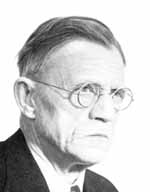Gallery of Philologists


Bernhard Karlgren
5 October 1889 - 20 October 1978
The great reverse missionaries like Legge and Waley in English, or Richard Wilhelm in German, who were knowledgeable in the commentarial tradition, had brought Chinese texts to the attention of the Western world. Karlgren was the first scholar to achieve results of which the Chinese commentarial tradition itself would have to take notice.
He did his undergraduate work at Uppsala at a time when dialect studies were popular. He began with Swedish (under the Slavic specialist and comparative phonologist J A Lundell), but soon conceived a desire to apply the methods of comparative phonetic reconstruction to Chinese. On receiving his degree in 1909, he spent November and December studying Chinese with Ivanov at St Petersburg, and in March of 1910 went on to China, where in less than two years he gathered materials from 24 Chinese dialects. Then it was more academic training: first, two months in London, in early 1912, and then to Paris, where he studied with Chavannes from September 1912 to April 1914. He was awarded his doctorate from Uppsala for a preliminary effort: the reconstruction of the Tang pronunciation of three thousand characters. He became a Professor of East Asian Philology at Goteburg University in 1918, with responsibility for teaching both Chinese and Japanese. He continued to extend and refine his dissertation work, and made a second visit to China in 1922. His doctoral thesis was published in three parts between 1915 and 1926, under the title Etudes sur la Phonologie Chinoise. This was the last of his scholarly works to be written in French. Though based on the previous work of the Ching philologists, it nevertheless took the subject in new directions. When in 1939 it was translated into Chinese (by the three leading Chinese linguists of the time, Y R Chao, Lo Ch'ang-p'ei, and Li Fang-kuei), it inaugurated a revolution in how Chinese scholarship from then on would view the Chinese language.
Karlgren left Goteburg in 1939 and moved to Stockholm, where he became Director of the Museum of Far Eastern Antiquities, essentially the King of Sweden's private collection on public display, and where he also acquired the museum's Bulletin as a personal journal. It became his chief medium of publication, some contributions being not articles but full-length books. His first publication from Sweden was of his extended phonetic reconstruction, including not only Tang (his "Ancient") but also classical pronunciations (his "Archaic"), relying for the latter on previous Manchu Dynasty researches by Wang Nyen-sun, Dwan Yw-tsi, and Dai Jvn on the rhymes of the Shr. His first reconstruction appeared in 1940 as Grammata Serica. Passing over World War 2 (during which difficult period of Swedish neutrality, Karlgren wrote three novels intended for a popular audience, under the name of Klas Gullman), we note the appearance in 1954 of its counterpart, the Compendium of Phonetics in Ancient and Archaic Chinese. The presentation of the system concluded with Grammata Serica Recensa in 1957. It contains all the roughnesses that one would expect of a pioneering work. It is also true that no one in those days who lacked a copy could be said to be current with Sinology. The counterparts of these phonetic researches were the philological ones: the glosses on the Shr (1942, 1944, 1946) and the Shu (1948, 1949). These are still a routine reference for anyone seriously engaged with those texts.
As even his own students admitted, Karlgren was waspish in person and in print. He did not suffer gladly those who ventured to disagree with him - even, or especially, when (as with Kennedy on tonal rhymes in the Shr, or Waley in his interpretations of some of the Shr poems) they were right. The comparative method which had been developed over centuries in Europe was not after all precisely employed in his studies of Chinese: Instead of reconstructing the earlier language from his dialect materials, he applied them to the recovery of the phonetic system of a dictionary, the Chye Ywn, which is easily shown to be an interdialectal compromise.
Even a student, in those heady times, could see points that Karlgren had gotten wrong. What Karlgren had done right was to put the whole subject, traditionally based but also systematically modernized, into the hands of just such students, who would otherwise have had no purchase on the subject at all.
For Chinese literature, Karlgren had contempt. One remark, passed around among the students of the day, was that one had to toil through the jungle of the Chinese language to reach the desert of Chinese literature. But even here, Karlgren had his virtues. He refused to romanticize China. His most enduring contribution may be his disposition to treat China as one more country to which the standard methods of scientific inquiry may validly be applied.
Readings
- Göran Malmqvist. Bernhard Karlgren: Ett Forskarporträtt. (Stockholm) Norstedts 1995
1 Dec 2005 / Contact The Project / Exit to Gallery Index Page

